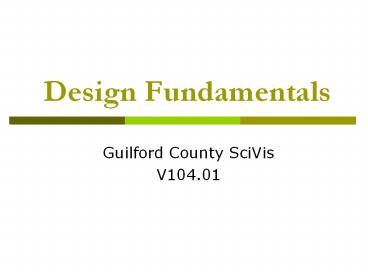Design Fundamentals - PowerPoint PPT Presentation
1 / 23
Title:
Design Fundamentals
Description:
Design Fundamentals Guilford County SciVis V104.01 The Aspects of Design The Principles of Design The Principles of Design Informal balance is asymmetrical. – PowerPoint PPT presentation
Number of Views:604
Avg rating:3.0/5.0
Title: Design Fundamentals
1
Design Fundamentals
- Guilford County SciVis
- V104.01
2
The Aspects of Design
- Problem solving is the understanding of what is
needed to solve a problem, which includes design,
making choices and revisions. - Visual Communication is the art of seeing by
using pictures and words to convey information
about different ideas and concepts. - Function and information refer to the purpose and
value of design as well as the message conveyed
with respect to a selected audience.
3
The Principles of Design
- Balance is the optical illusion of equal spacing
of objects. - Formal balance is symmetrical. When elements on a
page can be centered and/or evenly divided both
horizontally and vertically it has symmetry.
Symmetrical balance is generally for more formal,
orderly layouts. These layouts often convey a
sense of tranquility, familiarity, elegance or
serious thought.
4
The Principles of Design
- Informal balance is asymmetrical. It involves
placement of elements in a manner that allows
elements of varying visual weight to balance
one another around an imaginary point. For
example, it is possible to balance a heavy weight
with a cluster of lighter weights on equal sides
of the imaginary line.
5
The Principles of Design
- Rhythm is a reoccurring movement or pattern,
which can produce a feeling of motion in the
design. Size, shape, color, spacing, angles and
texture of the materials are all factors in
placing rhythm in a design and can help lead the
eye in some direction. Different types of rhythm
will produce different effects in the design. - Repetition repeating similar elements in a
consistent manner. - Variation change in form, size or location.
6
Examples of Rhythm
7
The Principles of Design
- Proportion is the relative size of one object in
comparison to another. The human body is a
considered an ideal proportion based on the size
relationships between the body and the head. A
caricature is funny because the head is out of
proportion.
8
The Methods of Design
- Emphasis is the method used to draw attention to
a part of the design by making it the focal point
or the main idea. There are common techniques
that are used to add emphasis in a design - Use contrasting elements, (big, small, thick,
thin, negative, positive). - Use color for the most important element.
- Reverse an element out of the background.
9
Examples of Emphasis
10
The Methods of Design
- Unity is the completeness and harmony of a
design. Unity is achieved when all the elements
belong together. Several methods of organization
are used to produce unity in the design - Grouping
- Using a grid (subdivision of space)
- Repetition means repeating certain elements
throughout the entire design. Using repetition
can pull the design together (using a theme of
squares then using different sizes and shapes of
squares and rectangles). Example using a
repeated background on a PowerPoint presentation.
11
The Methods of Design
12
The Elements of Design
- Line has length, position and direction and is
either visible or invisible. A line (curve) is
basically any distance between two points. Lines
can take on a variety of shapes and functions - Connectors and separators
- Outlines
- Graphs and grids
- Symbolism
13
Examples of Lines
14
The Elements of Design
- Shape is any form that occupies and defines
negative and positive space. Shape is anything
that has width, shape or depth. There are three
types of shapes - Geometric (triangles, squares, circles)
- Natural (animals, plants, human)
- Abstract (simplified versions of natural shapes)
15
Examples of Shapes
16
The Elements of Design
- Color is the hue of pigment or light and is
produced by the subtraction or addition of
primary and secondary colors produced from light.
Color is the primary tool for symbolism in
communication. There are different uses of color - Attract the eye
- Produce visual stimuli
- Organization.
- Provoke emotional response
17
Examples of Color
18
The Elements of Design
- Texture is the look or feel or any object or
surface. The appearance is either visual
(illusionary) or tactile (physical to touch).
Patterns are good examples of visual texture.
19
The Elements of Design
- Space is the negative or positive area that an
object or objects occupy in an area. Using
simple principles can control the relative
position of every element - White space
- Overlapping elements
- Value
20
Examples of Space Usage
21
The Elements of Design
- Size is how big or small objects are in relation
to the space they occupy. The primary roles size
plays in design - Function (the age of the audience older people
would need type set larger to aid help in
reading) - Attractiveness (add interest by cropping or
scaling the elements) - Organization (make the important element the
largest and the least important the smallest)
22
Examples of Size Usage
23
The End































